La Réole, Gironde, Nouvelle-Aquitaine 作者: 来源: 发布时间:2020-12-30
I. Population and Area
Total Area: 12.5 km2 (4.83 sq mi)
Population in 2017: 4 356
Population Density: 348.5/km2 (902/sq mi)
II. Natural Geography (environment and resources)
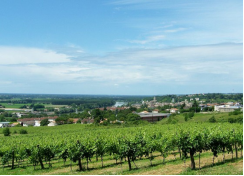
View from the place called La Recluse, in the east
La Réole, is a fortified town around a priory located in the east of the Gironde department. The town is located 62 km southeast of Bordeaux, the capital of the department, and is 19 km east of Langon, chief town of the district 1.
The city is mainly located on the right bank (north). The southern part of the city forms the hamlet of Rouergue.
The territorial extent of the commune is 1,250 hectares, a figure lower than the average of Gironde’s communes which is 1,845 hectares. This territory consists of:
1. The right bank, north of the Garonne, making up the most important part of the municipal territory, the real city of La Réole being located on a rocky outcrop overlooking the river.
2. The left bank, south of the Garonne, forming the locality of Rouergue.
The municipal area of La Réole is located on the Garonne over a distance of about seven kilometers.
The city is crossed by two streams, today channeled over most of their courses, Charros to the west and Pimpin to the east which form two valleys and which flow into the Garonne.
Transportation:
1. Rail services:
Railway services are provided by the SNCF TER Nouvelle-Aquitaine network on the Bordeaux - Sète line. From La Réole station, the transport time to Bordeaux-Saint-Jean station is 35 to 45 minutes, that to Toulouse-Matabiau station is approximately 2 hours. La Réole station (June 2009)
2. Road services:
The town is served, as part of the TransGironde urban transport network, by line No. 510, Sauveterre-de-Guyenne - La Réole - Monségur circuit provided by the buses of the transporter A.R.T.S. (Réolaise Transport and Services activity).
III. GDP
Employment income (%): 51.6 (2016)
Poverty rate by age group of the tax advisor(%): 29 (2016)
Average employment income (€): 1,918 net per month (23,017 net per year)(2014)
IV. Industrial Characterisitics
La Réole is famous for the national label: City of Art and History.
As the 20th century progressed, La Réole played the role of a regional economic centre, second to Bordeaux. More recently, the administrative responsibility has moved to nearby Langon. La Réole now is an important town centre in the Entre-Deux-Mers wine region of the Bordeaux classifications and has concentrated on tourism to stimulate the town economy.
In a context of increased metropolization, the revitalization of town centers becomes essential for the sustainable development of rural areas. The “La Réole 2020 project” is a part of this.
V. Attractions
Le Pont du Rouergue (The Rouergue Bridge)
To better discover the narrow streets as well as the historic monuments (from the 13th to the 18th century) of La Réole, you just need a walk. By browsing this signposted circuit offered by the city, you will discover "La Réole Historique" hidden.
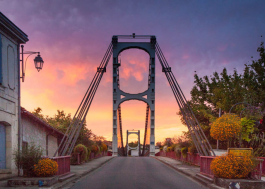
This bridge is surprisingly close to the habitat that surrounds it: the anchors of the carrying cables are invited between the tables of the terraces of a café-restaurant or are embedded in the ground in the middle of a sidewalk. It is rare to share such an intimity with an engineering structure ...
The 170-meter-long bridge, suspended over the Garonne, was built in 1934 and inaugurated the following year. It was tolled until 1972: it cost 1 cent for the passage of a pedestrian.
It is a suspension bridge with an apparent articulation at the foot of the pylon and on the deck. The lines start from the main carrying cable, descending vertically to the railings. By its triangulation, this railing constitutes a longitudinal truss beam which gives sufficient stiffness to the structure. Under the bridge, transverse metal beams provide transverse stiffness and allow it to overhang the side pedestrian paths.
2. L’Église Saint-Pierre (The Church of St. Peter)
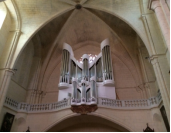
The church is located on Place Albert-Rigoulet, adjoining Le Prieuré des Bénédictins (The Priory of the Benedictines).
The construction of the Saint-Pierre priory church began in the 13th century. The nave, the most spacious in Gironde after that of Saint-André de Bordeaux, was endowed with an ogival vault during important works of the XVIIth century, intended to restore a building badly damaged by the Wars of Religion.
The “current” pulpit from the 18th century was recovered from the old Saint-Michel church. In front of it is a painting attributed to the Spanish painter Valdes Leal of the Seville School, dated 1666, "The Marriage of the Virgin". The church has a listed organ from 1765 by the famous organ builder J.B. Micot. This instrument was moved to Bordeaux in 1803 to "refurnish" the sacked cathedral during the Revolution. It is then transferred to Ste Croix church until 1985.
Parish : La Réole Monségur
phone number: 05 56 61 30 56
05 56 61 01 94
fax: 05 56 61 11 59
email: egliseenreolais@orange.fr
3. Le Prieuré des Bénédictins (The Priory of the Benedictines)
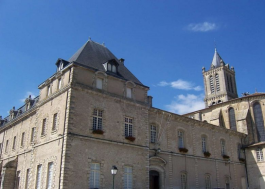
Le Prieuré des Bénédictins is a famous landmark of La Réole. It is an attraction for holidaymakers during a stay in the region.
The town of La Réole takes its name from the Latin Regula designating the rule of Saint Benedict followed by the priory. The presence of a monastery is attested from the High Middle Ages in these places then designated under the name of Squirs. It is linked to the abbey of Fleury, from 997 BC. Abbon de Fleury was assassinated by the monks during an inspection there in 1004.
The current buildings, renovated or reconstructed for several times, dating from the 18th century (1704-1774), the priory became property of the State during the Revolution after the expulsion of the monks.
Today, the priory houses the town hall of La Réole. The district court which was located in the Priory buildings, next to the town hall, was abolished as of January 1, 2010 as part of the Reform of the judicial card.
The building was listed as a historic monument in 1925. The protected elements, staircase, vault, door, fence, support ramp and grid, were in 1954 and 1965.
All the wrought iron elements are the work of Blaise Charlut (1717 - 1792), ironworker of Réolais art.
4. L’ancien hôtel de ville (The old town hall)
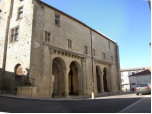
L’ancien hotel de ville is located between the Place du Loup and the Place des Martyrs-de-la-Résistance, whose the construction is due to Richard Coeur-de-Lion (1157-1199). L’ancien hotel de ville has suffered numerous alterations over the centuries: Romanesque capitals, flamboyant Gothic balcony, Renaissance mullioned windows.
Its ground floor served for a long time as a prison and then as a grain market (the Réolais still call it the "old market").
Five capitals cap its columns: two in re-use of Corinthian style from the Gallo-Roman period, three novels whose decoration is very characteristic of the civil art of the twelfth century.
The city's twelve jurates held their assemblies in the large hall on the first floor. The ground floor was a grain hall. The building was classified as a historic monument in 1913.
The building now houses an exhibition hall.
VI. History
Founded in 977, La Réole has a history and a culture remarkable for its richness and diversity. Without moving towards the status of a city-museum, which it has never agreed to become, la Réole revives its history. It invests its heritage to project itself into the future. Many of its traditional assets, which have remained intact, are the pride of its inhabitants and arouse the curiosity of its visitors.
La Réole, a veritable balcony overlooking the Garonne, has preserved an exceptionally rich heritage. For 1000 years, the city has developed around the priory of the Benedictines, tracing three successive enclosures around this promontory. From half-timbered houses to 18th century mansions, passing by Art Deco style villas, La Réole offers a multiple face.
There is evidence of a Roman villa, La Pontesa, with an adjoining cemetery which has been dated to be from the 3rd or 4th century. There were other Roman villas nearby. At this time in the region, there were Roman buildings every kilometre and a half or so. Evidence of later dwellings on the La Pontesa site show that it was inhabited between the 7th and 8th centuries. Nineteen sarcophaguses and funeral articles have been found on this site. La Réole grew up round a monastery founded in the 7th or 8th century, which was reformed in the 11th century and took the name of Regula, whence that of the town. During the Middle Ages, La Réole was a royal town, administered by six jurats (pre-revolution municipal officers), who were elected by the town's bourgeois. The law was upheld in the name of the King. During a significant period of time, La Réole was the second most important town of Guyenne, after Bordeaux. Bordeaux's parliament was exiled to La Réole during the 17th century in 1678 and 1690.
Archaeological discoveries
1. The archaeological zoning by-law of the prefect of the Aquitaine region identifies nine areas to be protected on October 19, 2004:
1) Bourg de La Réole and its surroundings: occupations from Antiquity to the Middle Ages,
2) Le Calonge: ancient building with a basilica plan,
3) Le Luc: Medieval and modern fortified house,
4) The Living Room: Medieval and modern fortified house,
5) Former parish of Saint-Aignan: ancient and medieval occupations,
6) Luciot: ancient habitat,
7) La Recluse, Le Mirail and Roquebuse: necropolis and occupations from Antiquity to modern times,
8) Frimont, Jurats, Fontfrède: Neolithic occupations, Bronze Age and Middle Ages,
9) Saint-Aignan and Luciot: ancient and medieval occupations.
2. A dagger and swords from the Bronze Age were raised during dredging near the Rouergue bridge.
3. Several coins from the beginning of the second century BC have been found in different places.
4. An ancient necropolis was reported in 1873 100 meters from the present town hall; it included bones, terracotta urns and furniture from the High Empire. Nearby, in 1864, several Tegulae tombs had already been discovered.
5. A later Gallo-Roman villa, known as the Pontesia villa, dating from the Lower Empire, has been the subject of numerous surveys since the eighteenth century; surveys resumed in the 20th century, revealing material and decorative elements in marble as well as painted plasters. This same site was reoccupied by a Merovingian necropolis; it was excavated in 1969 by Mr. Gauthier, who dates from the end of the 7th century or the beginning of the next century. Three stone sarcophagi are on display in the cloister of the priory.
At the localities of Levite, Calonge and La Bombe, aerial surveys by F. Didierjean in May 1984 revealed two Gallo-Roman buildings, including a fanum (an Ancient roman temple) and a basilica plan construction.
Social and cultural facilities
1. Film:
La Réole has been a city of cinema since the mid-twentieth century, in particular thanks to the enthusiasm of an amateur filmmaker of the time, Jean Saubat. He has produced numerous filmed documents on the local life of the city during and after the Second World War.
Although it was only populated by around 3,500 inhabitants at the time, three rooms were set up there in the post-war period: the Casino, near the town hall, the Rex on Place de la Liberation and a room which had was created on the premises of the Amicale laïque, at the eastern entrance to the city.
Today, the Rex, a room classified Art & Essay, is still active thanks to the association “L'Écran Réolais” which takes care of the exploitation and animation of the place and coordinates actions of education in cinema on the territory . Open every day of the year, the Rex offers around fifteen screenings each week with exclusive films, a large selection of Art & Essay works and a program for young audiences. It is one of the 29 local cinemas located in Gironde, and was sponsored by Édouard Molinaro.
2. Museum: La Réole housed an automobile, agricultural, military and railway museum. This private museum closed for lack of attendance during the summer of 2006 and an auction of vehicles took place on Sunday, October 1, 2006. A municipal museum, classified as "Musée de France" is also closed.
3. Music school: Music education is one of the priorities of the French intermunicipal association. The Réolais Music School, integrated into the Network of Rural Music Schools (with the establishments of Monségur, Pellegrue and Auros) is located rue des Menuts and has a capacity of 120 students. The school offers lessons in drums, piano, guitars, bass, violin, recorders and transverse, clarinets, saxophones and singing.
4. Library: Created in 1838 at the request of the deputy Dussaulx, the library is located today in the former priory of the Benedictines, in the basement of the town hall premises, facing the Garonne plain. It was installed there in 1889.
There are several thousand books, including an important ancient collection (antiphonaries of the 17th century, two copies of the Encyclopedia Diderot and Alembert, etc.).
VII. Other information
Medieval town nestled on the banks of the Garonne, La Réole can claim the title of the smallest City of Art and History in France! The town, founded in 977, has preserved a rich heritage to discover along its cobbled streets.
The La Réole 2020 project has four axes:
1. The first concerns old private buildings to be rehabilitated and land recycling on two urban blocks, Lamar and La Marmory;
2. The next one deals with the creation or the rehabilitation of structuring public facilities, around the Liberation Square (administrative), the old priory (cultural) and the old town hall of the 12th century (historic );
3. Then, interventions in public spaces in the heart of the city to promote links between the old center, the town center, the station and the peripheral districts, enhancing the Garonne quays;
4. Finally, the development of economic activity by enhancing the historical and cultural heritage of the old center (City of art and history label) and the project to create a tourist accommodation offer; commercial and craft activity, including support for arts and crafts, is also concerned.
VIII. Contact information
La Réole town hall address :
Mairie de La Réole
Esplanade du Général-de-Gaulle
BP 50051
33191 La Réole Cedex
Opening hours of the town hall:
Saturday: 09h00 - 12h00
From Monday to Friday: 09h00 - 12h00, 13h30 - 16h00
Mayor: Bruno Marty (Mandate : 2014-2020)
Phone number: 05 56 61 10 11
Fax: 05 56 71 21 57
Mail: mairie@lareole.fr
Website: http://www.lareole.fr
